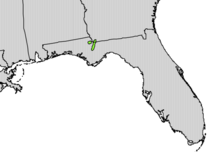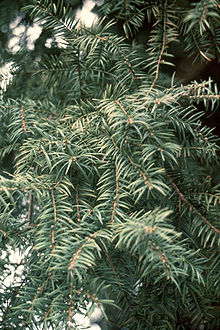User:Mottezen/sandbox
 Torreya Guardian Fred Bess shows seeds growing in his grove of Florida Torreya trees, Cleveland Ohio (2018) | |
| Formation | 2004 |
|---|---|
| Founder | Connie Barlow |
| Type | Self-organized group |
| Purpose | Conservation of the Torreya taxifolia |
Region served | United States of America |
| Methods | Unregulated assisted migration |
| Website | torreyaguardians.org |
The Torreya Guardians is a self-organized group of conservationists dedicated to facilitating the assisted colonization of the Florida torreya by rewilding it in more northern parts of the United States. Founded in the early 2000s, the group is often mentioned as an instigator of the Assisted migration of forests in North America for conservation purposes
Background
[edit]The endangered Florida torreya
[edit]
Climate change
[edit]Origins
[edit]
The Torreya guardians was founded in the 2004 by Connie Barlow, an American science writer and amateur horticulturalist.[1] It is composed of conservationists, biologists, ecologists and other citizens, mostly based in the states of Florida, Georgia, South Carolina and North Carolina. Before the foundation, they were searching for ways to better protect the Torreya taxifolia from extinction, and worried that traditional conservation measures focused on rehabilitating the tree in its historical range were destined to failed, as well as being very expensive.[2]
Then, early members found reports that other trees of the Torreya genus would migrate to higher altitudes when higher average temperatures put them at risk.[3] They saw in this a solution to the plight of the Florida Torreya, and hypothesized that the tree would thrive if they were relocated to lands north of its historical range.[2] It would thus be better suited to survive in a cooler climate.[4]
Major American conservation institutions were unwilling to test their hypothesis. Plant assisted colonization projects had never been implemented before in the united states for the purpose of colonization, so it was rejected. Instead, the United States Fish and Wildlife Service is trying to protect this species by managing the diseases affecting it in its native range, with limited success.[1]
The two sides came to a head in 2004 when the environmentalist magazine Wild Earth published a series of the dueling articles on what to do about the Florida torreya. Mark Schwartz, an American conservationist who works for the preservation of the Florida Torreya since 1988, wrote the piece opposing the assisted migration proposal. Connie Barlow and zoologist Paul Martin wrote the article in favor of an assisted migration program for the species. Barlow and Martin argued that the Florida Torreya was likely not originally native to Florida, but had instead been pushed south during the previous ice age. When the ice retreated, it had trouble migrating back up to cooler climates.[1]
For years, the conversation efforts of the Florida Torreya has resulted in "indefinitely maintaining the Florida torreya in a network of potted orchards" to prevent the tree from dying out in its historical range. Connie Barlow, on the other hand, believed the effort should focus on helping the tree thrive in the wild.[5]
Implementation of assisted migration
[edit]
While unsupported by conservation institution, planting trees outside their native range is not illegal in the united states if it is done on the private property of private citizens. The movement of non-commercial plants across states lines is currently unregulated in the country. The nascent Torreya Guardians took advantage of this loophole to implement their own assisted migration project outside established institutions.[6]
The Torreya Guardians saw North Carolina as particularly hospitable for the Florida Torreya because trees of this genus have lived at the Biltmore Gardens, a greenhouse in nearby Asheville, for almost a century. The Biltmore Estate is currently home to the oldest surviving Florida Torreya trees.[7] In 2005, the Biltmore Gardens donated 110 to Lee Barnes, a member of the Torreya Guardians. The seeds were planted, and after three years of growing in pots, the trees were rewilded on wild, regrowth forest properties near Waynesville, North Carolina.[8]
Over the next few years, samplings were also given to planters in 12 states, including Tenessee, Oregon, Ohio and New Hampshire. These planters do not necessarily have scientific training. They share information with each other though the internet.[7]
Governance
[edit]On their website, the Torreya guardians explain that "there are no by-laws, officers, board, staff, overhead costs, dues, formal organizational structure, or physical location to this organization".[9][5]
On the topic of official communications, the Torreya Guardians website further notes that the organization "does not speak or take action as a group, but instead encourages subsets of those involved to post ideas and initiatives on this website and to help establish links with synergistic organizations and websites".[9][5]
According to member Clint Bancroft, the Torreya Guardians network is mostly maintened by the work of the founder Connier Barlow.[7]
Goals
[edit]The Torreya Guardians are currently studying how the Florida torreya grows in various climates. Members of the group have volunteered to plant samplings on the tree on their properties in different states.[10]
Results
[edit]Because the Torreya Guardians are a decentralized group, they do not have a systemic data-collection approach. Participants simply share their experience on the Torreya Guardians website.[7] Is some states, such as North Carolina, the Florida Torreya samplings are thriving despite not being in their native range. In other states with an even colder climate, such as New Hampshire, the tree manages to survive, but is having more trouble growing than in warmer places.[10]
After about a decade of implementation, the group's results were mixed. The relocated tree's health varied across states. Some were harmed by summer droughts and harsh winters. However, many trees remain alive and are thriving in their new environment.[7]
Reception
[edit]
The conservation community has mixed feelings toward the Torreya Guardians. They have been called a "rogue" group for not following the guidelines of the International Union for Conservation of Nature.[11] When they started their endevour, the assisted migration of trees in North America was considered a "radical conservation idea".[1]
The Torreya Guardians have attracted many vocal critics since their inception. Mark Schwartz, who wrote the Wild Earth article rebuking the proposed assisted migration of the Florida Torreya noted earlier, believed the group's plan to follow through with their proposal without institutional backing to be misguided. He argued that implementing assisted forest migration poses too much unknown risks of possibly contaminating host ecosystems. He was particularly worried about the precedent the assisted migration of the Florida Torreya would set, as well as the possibility of spreading the diseases afflicting the tree to new ecosystems.[12] These concerns were shared by Jenny Cruse-Sanders of the Atlanta Botanical Garden, who also criticized the use of seedling from potted trees. These seedlings have been in conservation for generation, and thus might be genetically different from the Torreyas that used to thrive in the wild.[5]
Many skeptical conservationists compared their efforts to other misguided attempts at assisted plant colonisation, such at the integration of Kudzu in the United States.[1] Mark Schwartz point out that the Florida Torreya is unlikely to become an invasive species like the Kudzu, but he remains concerned about the precedent that the Torreya Guardian could establish.[12]
At the same time, the group's actions forced many conservationists to rethink their traditional methods of conservation.[7] The Torreya Guardians had proved that assisted migration could be done without sophisticated conservation techniques and for little cost. Working groups were initiated to address the question of climate change adaptation, and to consider the scientific, legal, and ethical ramifications of assisted migration. This includes considering the ramification of risking a species going extinct due to a human failure to consider relocating them to a climate where they could thrive.[1]
Indeed, many scholars believe that the risk of spreading invasive species due to assisted migration is small and worth taking. For Boston University ecologist Richard Primack, losing having endangered species go extinct would be a worse tragedy.[5] Connie Barlow says that, despite the immense backlash her group recieved it its early years, the group is at the forefront of radical ecologist perseptive that's becoming increasingly mainstream.
References
[edit]- ^ a b c d e f Berdik, Chris (12 October 2008). "Driving Mr. Lynx". The Boston Globe. Retrieved 2021-08-07.
- ^ a b Greenfieldboyce, Nell (7 February 2011). "A Growing Risk? Endangered Plants For Sale Online". NPR.org.
- ^ Sanchez, Casey (25 March 2016). "Book Review: "The Quiet Extinction: Stories of North America's Rare and Threatened Plants" by Kara Rogers". Santa Fe New Mexican. Retrieved 27 July 2021.
- ^ Powell, Devin (24 August 2009). "Should Species be Relocated to Prevent Extinction?". livescience.com. Retrieved 28 July 2021.
- ^ a b c d e Marinelli, Janet (July 2008). "Guardian Angels". Audubon (Magazine). Archived from the original on 12 June 2012.
- ^ Shirey, Patrick D.; Lamberti, Gary A. (26 January 2011). "Regulate trade in rare plants". Nature. 469 (7331): 465–467. doi:10.1038/469465a. ISSN 1476-4687.
- ^ a b c d e f Schipani, Sam (4 October 2018). "Scrappy Group of Citizen Scientists Rallies Around One of World's Rarest Trees". Earth Island Journal. Retrieved 2021-08-08.
{{cite web}}: CS1 maint: url-status (link) - ^ "Efforts to Save Torreya Taxifolia from Extinction". torreyaguardians.org. Retrieved 2021-08-12.
- ^ a b "History of Torreya Guardians". www.torreyaguardians.org. Retrieved 2021-08-08.
- ^ a b Saari, Ashley (9 June 2021). "Mason man works with organization to research new habitats for endangered tree". Monadnock Ledger-Transcript.
- ^ Kahn, Brian (9 April 2019). "The Race to Save the Most Endangered Conifer in America". Gizmodo. Retrieved 2021-08-02.
{{cite web}}: CS1 maint: url-status (link) - ^ a b Schwartz, Mark (January 2005). "Conservationists Should Not Move Torreya taxifolia" (PDF). Wild Earth.
